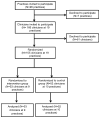Distance-Learning, ADHD Quality Improvement in Primary Care: A Cluster-Randomized Trial
- PMID: 28816912
- PMCID: PMC5657444
- DOI: 10.1097/DBP.0000000000000490
Distance-Learning, ADHD Quality Improvement in Primary Care: A Cluster-Randomized Trial
Abstract
Objective: To evaluate a distance-learning, quality improvement intervention to improve pediatric primary care provider use of attention-deficit/hyperactivity disorder (ADHD) rating scales.
Methods: Primary care practices were cluster randomized to a 3-part distance-learning, quality improvement intervention (web-based education, collaborative consultation with ADHD experts, and performance feedback reports/calls), qualifying for Maintenance of Certification (MOC) Part IV credit, or wait-list control. We compared changes relative to a baseline period in rating scale use by study arm using logistic regression clustered by practice (primary analysis) and examined effect modification by level of clinician participation. An electronic health record-linked system for gathering ADHD rating scales from parents and teachers was implemented before the intervention period at all sites. Rating scale use was ascertained by manual chart review.
Results: One hundred five clinicians at 19 sites participated. Differences between arms were not significant. From the baseline to intervention period and after implementation of the electronic system, clinicians in both study arms were significantly more likely to administer and receive parent and teacher rating scales. Among intervention clinicians, those who participated in at least 1 feedback call or qualified for MOC credit were more likely to give parents rating scales with differences of 14.2 (95% confidence interval [CI], 0.6-27.7) and 18.8 (95% CI, 1.9-35.7) percentage points, respectively.
Conclusion: A 3-part clinician-focused distance-learning, quality improvement intervention did not improve rating scale use. Complementary strategies that support workflows and more fully engage clinicians may be needed to bolster care. Electronic systems that gather rating scales may help achieve this goal. Index terms: ADHD, primary care, quality improvement, clinical decision support.
Conflict of interest statement
Figures


References
-
- Power TJ, Watkins MW, Anastopoulos AD, et al. Multi-Informant Assessment of ADHD Symptom-Related Impairments Among Children and Adolescents. J Clin Child Adolesc Psychol. 2015:1–14. - PubMed
-
- Harstad E, Levy S. Attention-deficit/hyperactivity disorder and substance abuse. Pediatrics. 2014;134(1):e293–301. - PubMed
Publication types
MeSH terms
Grants and funding
LinkOut - more resources
Full Text Sources
Other Literature Sources
Medical
Miscellaneous

